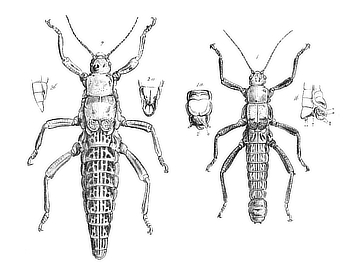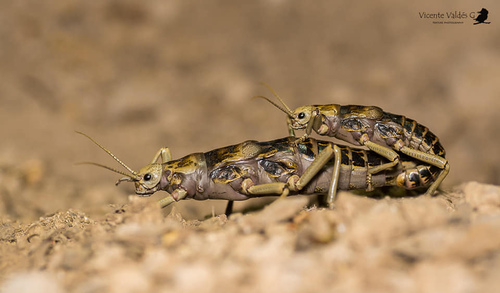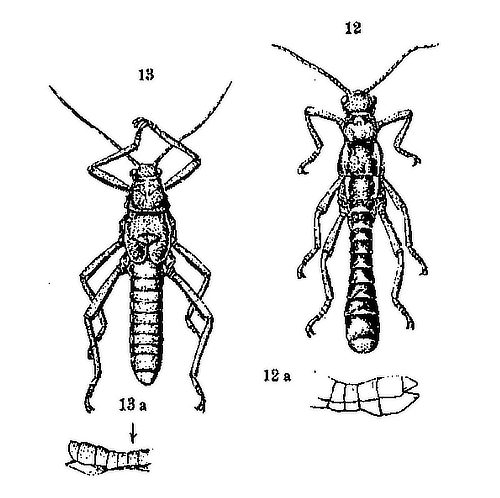- Introduction
- Astounding variety
- The stinky bug
- Hibernation
Shortly after starting to breed phasmids, more than 35 years ago, we came across the monographs of Westwood1) and Brunner/Redtenbacher2). These monographs depict many fascinating "sticky" creatures, including drawings of Agathemera.

Only quite recently more accurate scientific informations about this mysterious phasmids became publicly available, mainly by some chilean entomologists like A. Camousseight, A. Vera, M.C. Domínguez, C. Cubillos. In the literature section below you find a selection of interesting articles.
Ever since discovering Westwood's drawings, Agathemera's has been on top of our breeding wish list. Our interest in breeding Agathemera became further aroused, when rumores spread that "it is not possible to breed Agathemera". Their (assumed) requirements regarding climat and food plants are just too specifc, it's been said.... A phasmid that can' be cultivated, well that sounds like a superb challenge for us :) Just Argentina and Chile were too far away, and we did not become aware of any Agathemera being imported to Europe in the recent past.

So breeding Agathemera remained enigmatic and wishful thinking for a long time. Therefore we were very exited, when we finally received some Agathemera eggs in 2016. These were collected from wild-caught Agathemera luteola females from Capilla del Monte in Argentina. And that was the starting signal for one of the most interesting breeding projects we have been undertaking so far.
Prior to our approach to breed Agathemera there were merely two attempts:
- Conle & Hennemann3) attempted to breed Agathemerea crassa in the mid 90's in Germany. They have kept quite a large group of Agathemerea crassa in a fridge and fed them on a variety of (substitute) food plants, including bramble (Rubus spp.), Rhododendron spp. Hedera spp.. Thus they gained some initial insights into how to breed these enigmatic phasmids. The collected eggs did not hatch
- Vera & Camousseight4) were breeding Agathemera mesoauriculae in 2008 in Chile successfully for a full generation cycle (egg to egg), with apparently healthy individuals. As food plant they used Schinus molle (Anacardiaceae)

Cited literature
- Westwood. 1859. Catalogue of the orthopterous insects in the collection of the British Museum. Part I. Phasmidae
- Brunner von Wattenwyl & Redtenbacher. 1906-1908. Die Insektenfamilie der Phasmiden
- Conle, Hennemann, 1999: Bemerkungen zu Agathemera crassa (Blanchard, 1851) aus Chile nebst Beschreibung ihrer Eier. Entomologische Zeitschrift, 109(2): 82-85.
- Vera, Camousseight, 2008. Ciclo vital de Agathemera mesoauriculae, Rev. Chil. Ent. 34: 57-61
Interesting Agathemera related literature
- Camousseight. 2006 [2005]. Redefinicion del genero Agathemera, Rev. Chilena Ent. 31:13-20
- Conle, O.V. & Hennemann, F.H. (1999): Bemerkungen zu Agathemera crassa (Blanchard, 1851) aus Chile nebst Beschreibung ihrer Eier. Entomologische Zeitschrift, 109(2): 82-85.
- Cubillos, Claudio & Vera, Alejandro. (2020). Comparative morphology of the eggs from the eight species in the genus Agathemera Stål (Insecta: Phasmatodea), through phylogenetic comparative method approach. Zootaxa. 4803. 523-543.
- Domínguez, et al. 2009: Cladistic, biogeographic and environmental niche analysis of the species of Agathemera Stål (Phasmatida, Agathemeridae). Zootaxa, 2308: 43-57
- Simon, S.; Letsch, H.; Bank, S.; Buckley, T.R.; Donath, A.; Liu, S.; Machida, R.; Meusemann, K.; Misof, B.; Podsiadlowski, L.; Bradler, S. et al. Old World and New World Phasmatodea: Phylogenomics resolve the evolutionary history of stick and leaf insects. Front. Ecol. Evol. 2019, 7, 345.
- Vera, Alejandro & Pastenes, Luis & Veloso, Claudio & Méndez, Marco. (2012). Phylogenetic relationships in the genus Agathemera (Insecta: Phasmatodea) inferred from the genes 16S, COI and H3. Zoological Journal of the Linnean Society. 165.
- Astounding variety
- The stinky bug
- Hibernation
- To breed - or not to breed
- Food plants
- Agathemera biology